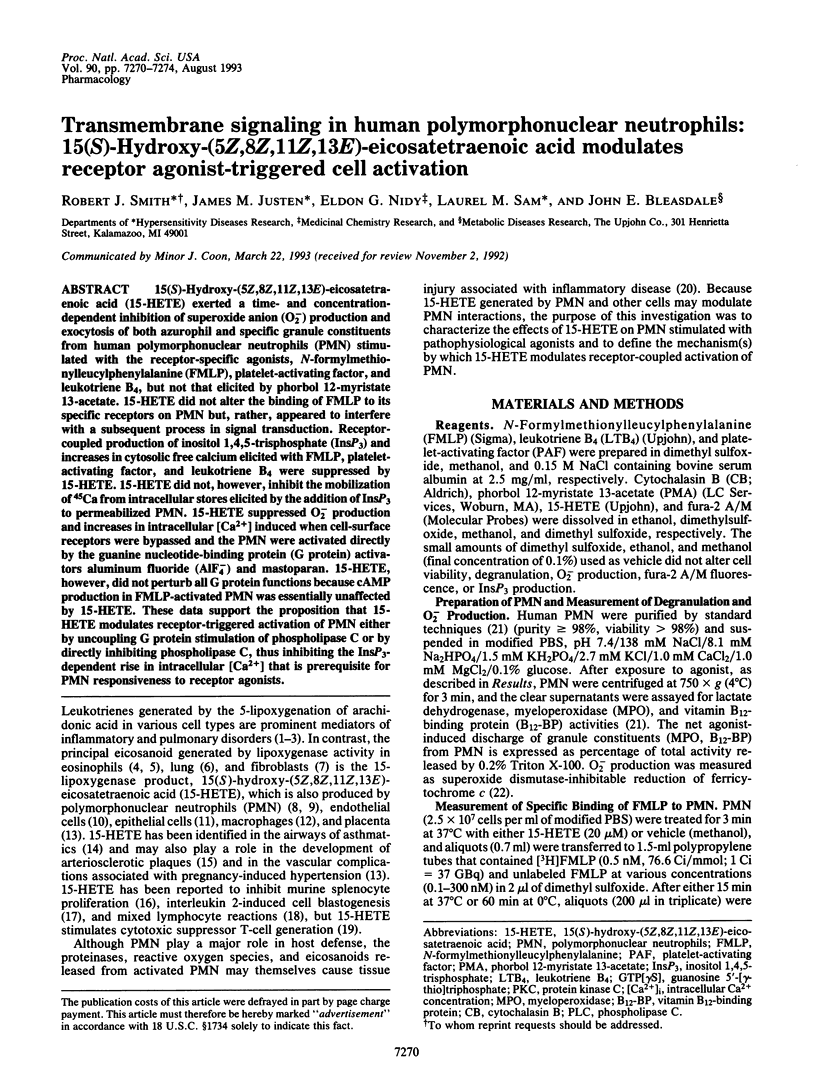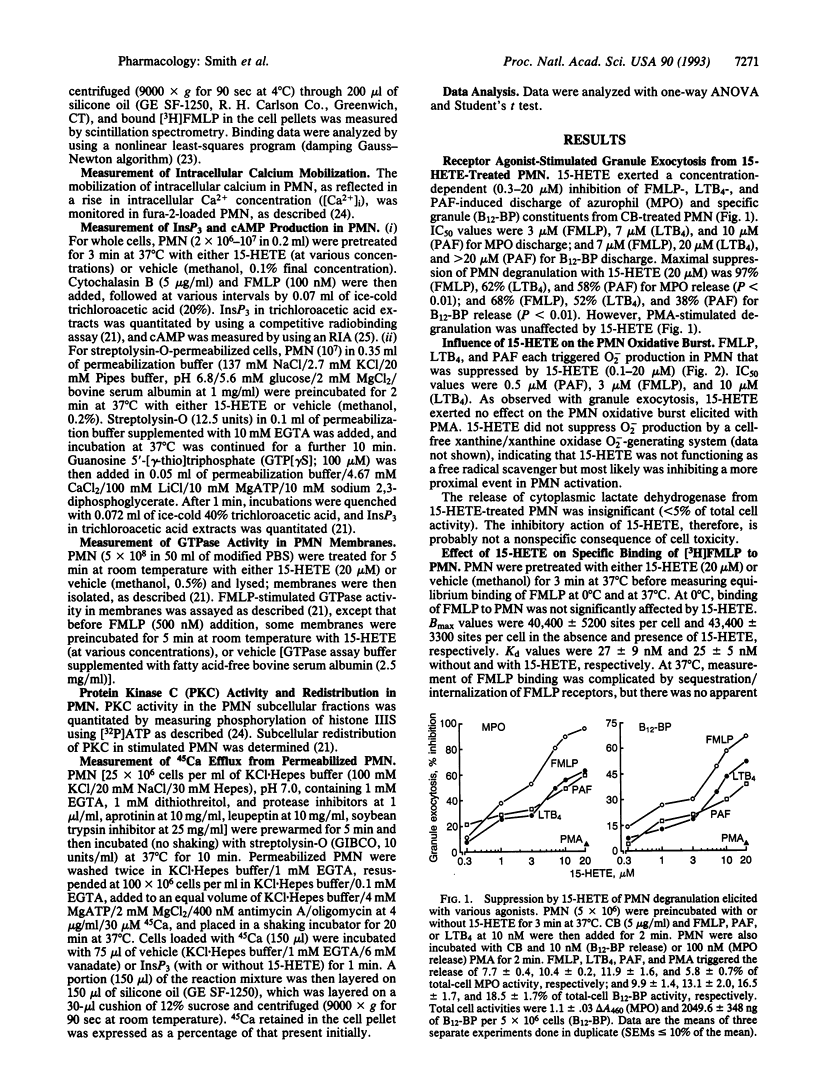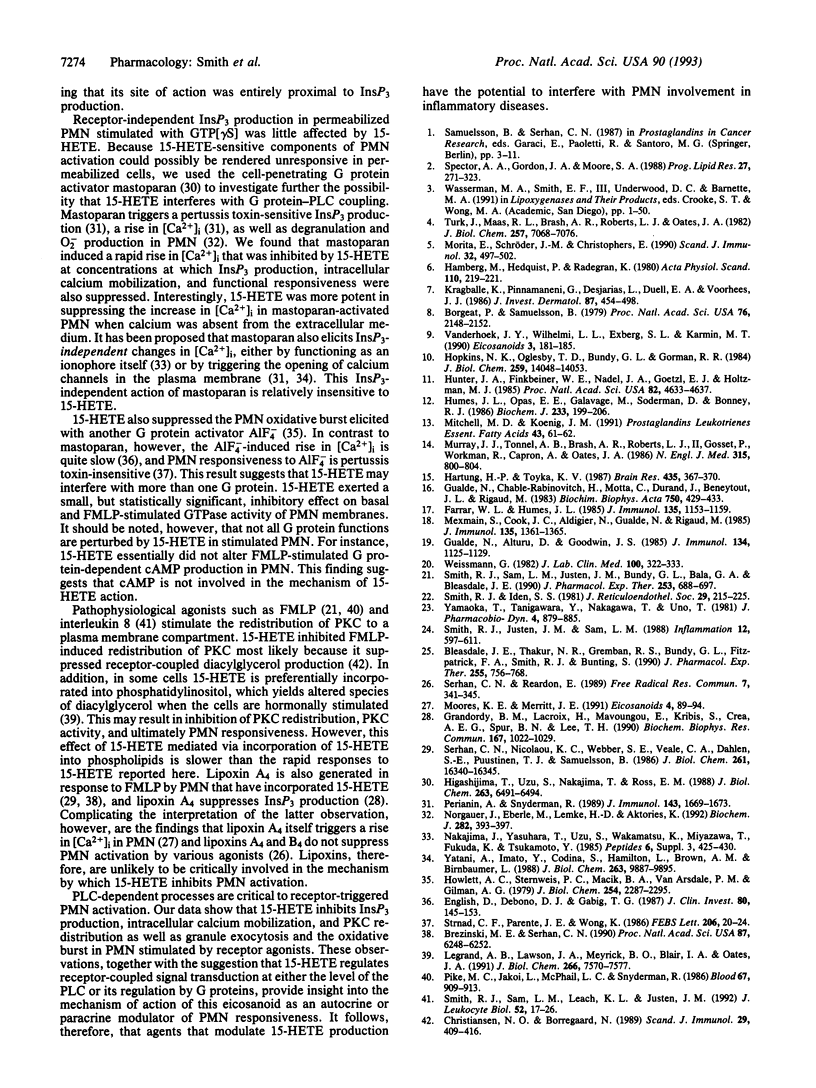Abstract
15(S)-Hydroxy-(5Z,8Z,11Z,13E)-eicosatetraenoic acid (15-HETE) exerted a time- and concentration-dependent inhibition of superoxide anion (O2-) production and exocytosis of both azurophil and specific granule constituents from human polymorphonuclear neutrophils (PMN) stimulated with the receptor-specific agonists, N-formylmethionylleucylphenylalanine (FMLP), platelet-activating factor, and leukotriene B4, but not that elicited by phorbol 12-myristate 13-acetate. 15-HETE did not alter the binding of FMLP to its specific receptors on PMN but, rather, appeared to interfere with a subsequent process in signal transduction. Receptor-coupled production of inositol 1,4,5-trisphosphate (InsP3) and increases in cytosolic free calcium elicited with FMLP, platelet-activating factor, and leukotriene B4 were suppressed by 15-HETE. 15-HETE did not, however, inhibit the mobilization of 45Ca from intracellular stores elicited by the addition of InsP3 to permeabilized PMN. 15-HETE suppressed O2- production and increases in intracellular [Ca2+] induced when cell-surface receptors were bypassed and the PMN were activated directly by the guanine nucleotide-binding protein (G protein) activators aluminum fluoride (AlF4-) and mastoparan. 15-HETE, however, did not perturb all G protein functions because cAMP production in FMLP-activated PMN was essentially unaffected by 15-HETE. These data support the proposition that 15-HETE modulates receptor-triggered activation of PMN either by uncoupling G protein stimulation of phospholipase C or by directly inhibiting phospholipase C, thus inhibiting the InsP3-dependent rise in intracellular [Ca2+] that is prerequisite for PMN responsiveness to receptor agonists.
Full text
PDF




Selected References
These references are in PubMed. This may not be the complete list of references from this article.
- Bleasdale J. E., Thakur N. R., Gremban R. S., Bundy G. L., Fitzpatrick F. A., Smith R. J., Bunting S. Selective inhibition of receptor-coupled phospholipase C-dependent processes in human platelets and polymorphonuclear neutrophils. J Pharmacol Exp Ther. 1990 Nov;255(2):756–768. [PubMed] [Google Scholar]
- Borgeat P., Samuelsson B. Arachidonic acid metabolism in polymorphonuclear leukocytes: effects of ionophore A23187. Proc Natl Acad Sci U S A. 1979 May;76(5):2148–2152. doi: 10.1073/pnas.76.5.2148. [DOI] [PMC free article] [PubMed] [Google Scholar]
- Brezinski M. E., Serhan C. N. Selective incorporation of (15S)-hydroxyeicosatetraenoic acid in phosphatidylinositol of human neutrophils: agonist-induced deacylation and transformation of stored hydroxyeicosanoids. Proc Natl Acad Sci U S A. 1990 Aug;87(16):6248–6252. doi: 10.1073/pnas.87.16.6248. [DOI] [PMC free article] [PubMed] [Google Scholar]
- Christiansen N. O., Borregaard N. Translocation of protein kinase C to subcellular fractions of human neutrophils. Scand J Immunol. 1989 Apr;29(4):409–416. doi: 10.1111/j.1365-3083.1989.tb01140.x. [DOI] [PubMed] [Google Scholar]
- English D., Debono D. J., Gabig T. G. Relationship of phosphatidylinositol bisphosphate hydrolysis to calcium mobilization and functional activation in fluoride-treated neutrophils. J Clin Invest. 1987 Jul;80(1):145–153. doi: 10.1172/JCI113040. [DOI] [PMC free article] [PubMed] [Google Scholar]
- Farrar W. L., Humes J. L. The role of arachidonic acid metabolism in the activities of interleukin 1 and 2. J Immunol. 1985 Aug;135(2):1153–1159. [PubMed] [Google Scholar]
- Grandordy B. M., Lacroix H., Mavoungou E., Krilis S., Crea A. E., Spur B. W., Lee T. H. Lipoxin A4 inhibits phosphoinositide hydrolysis in human neutrophils. Biochem Biophys Res Commun. 1990 Mar 30;167(3):1022–1029. doi: 10.1016/0006-291x(90)90625-w. [DOI] [PubMed] [Google Scholar]
- Gualde N., Atluru D., Goodwin J. S. Effect of lipoxygenase metabolites of arachidonic acid on proliferation of human T cells and T cell subsets. J Immunol. 1985 Feb;134(2):1125–1129. [PubMed] [Google Scholar]
- Gualde N., Chable-Rabinovitch H., Motta C., Durand J., Beneytout J. L., Rigaud M. Hydroperoxyeicosatetraenoic acids. Potent inhibitors of lymphocyte responses. Biochim Biophys Acta. 1983 Mar 1;750(3):429–433. doi: 10.1016/0005-2760(83)90181-9. [DOI] [PubMed] [Google Scholar]
- Hamberg M., Hedqvist P., Rådegran K. Identification of 15-hydroxy-5,8,11,13-eicosatetraenoic acid (15-HETE) as a major metabolite of arachidonic acid in human lung. Acta Physiol Scand. 1980 Oct;110(2):219–221. doi: 10.1111/j.1748-1716.1980.tb06656.x. [DOI] [PubMed] [Google Scholar]
- Hartung H. P., Toyka K. V. Leukotriene production by cultured astroglial cells. Brain Res. 1987 Dec 1;435(1-2):367–370. doi: 10.1016/0006-8993(87)91627-1. [DOI] [PubMed] [Google Scholar]
- Higashijima T., Uzu S., Nakajima T., Ross E. M. Mastoparan, a peptide toxin from wasp venom, mimics receptors by activating GTP-binding regulatory proteins (G proteins). J Biol Chem. 1988 May 15;263(14):6491–6494. [PubMed] [Google Scholar]
- Hopkins N. K., Oglesby T. D., Bundy G. L., Gorman R. R. Biosynthesis and metabolism of 15-hydroperoxy-5,8,11,13-eicosatetraenoic acid by human umbilical vein endothelial cells. J Biol Chem. 1984 Nov 25;259(22):14048–14053. [PubMed] [Google Scholar]
- Howlett A. C., Sternweis P. C., Macik B. A., Van Arsdale P. M., Gilman A. G. Reconstitution of catecholamine-sensitive adenylate cyclase. Association of a regulatory component of the enzyme with membranes containing the catalytic protein and beta-adrenergic receptors. J Biol Chem. 1979 Apr 10;254(7):2287–2295. [PubMed] [Google Scholar]
- Humes J. L., Opas E. E., Galavage M., Soderman D., Bonney R. J. Regulation of macrophage eicosanoid production by hydroperoxy-and hydroxy-eicosatetraenoic acids. Biochem J. 1986 Jan 1;233(1):199–206. doi: 10.1042/bj2330199. [DOI] [PMC free article] [PubMed] [Google Scholar]
- Hunter J. A., Finkbeiner W. E., Nadel J. A., Goetzl E. J., Holtzman M. J. Predominant generation of 15-lipoxygenase metabolites of arachidonic acid by epithelial cells from human trachea. Proc Natl Acad Sci U S A. 1985 Jul;82(14):4633–4637. doi: 10.1073/pnas.82.14.4633. [DOI] [PMC free article] [PubMed] [Google Scholar]
- Kragballe K., Pinnamaneni G., Desjarlais L., Duell E. A., Voorhees J. J. Dermis-derived 15-hydroxy-eicosatetraenoic acid inhibits epidermal 12-lipoxygenase activity. J Invest Dermatol. 1986 Oct;87(4):494–498. doi: 10.1111/1523-1747.ep12455564. [DOI] [PubMed] [Google Scholar]
- Legrand A. B., Lawson J. A., Meyrick B. O., Blair I. A., Oates J. A. Substitution of 15-hydroxyeicosatetraenoic acid in the phosphoinositide signaling pathway. J Biol Chem. 1991 Apr 25;266(12):7570–7577. [PubMed] [Google Scholar]
- Mexmain S., Cook J., Aldigier J. C., Gualde N., Rigaud M. Thymocyte cyclic AMP and cyclic GMP response to treatment with metabolites issued from the lipoxygenase pathway. J Immunol. 1985 Aug;135(2):1361–1365. [PubMed] [Google Scholar]
- Mitchell M. D., Koenig J. M. Increased production of 15-hydroxyeicosatetraenoic acid by placentae from pregnancies complicated by pregnancy-induced hypertension. Prostaglandins Leukot Essent Fatty Acids. 1991 May;43(1):61–62. doi: 10.1016/0952-3278(91)90134-q. [DOI] [PubMed] [Google Scholar]
- Moores K. E., Merritt J. E. Lipoxin A4 elevates cytosolic calcium in human neutrophils. Eicosanoids. 1991;4(2):89–94. [PubMed] [Google Scholar]
- Morita E., Schröder J. M., Christophers E. Production of 15-hydroxyeicosatetraenoic acid by purified human eosinophils and neutrophils. Scand J Immunol. 1990 Nov;32(5):497–502. doi: 10.1111/j.1365-3083.1990.tb03190.x. [DOI] [PubMed] [Google Scholar]
- Murray J. J., Tonnel A. B., Brash A. R., Roberts L. J., 2nd, Gosset P., Workman R., Capron A., Oates J. A. Release of prostaglandin D2 into human airways during acute antigen challenge. N Engl J Med. 1986 Sep 25;315(13):800–804. doi: 10.1056/NEJM198609253151304. [DOI] [PubMed] [Google Scholar]
- Nakajima T., Yasuhara T., Uzu S., Wakamatsu K., Miyazawa T., Fukuda K., Tsukamoto Y. Wasp venom peptides; wasp kinins, new cytotrophic peptide families and their physico-chemical properties. Peptides. 1985;6 (Suppl 3):425–430. doi: 10.1016/0196-9781(85)90409-7. [DOI] [PubMed] [Google Scholar]
- Norgauer J., Eberle M., Lemke H. D., Aktories K. Activation of human neutrophils by mastoparan. Reorganization of the cytoskeleton, formation of phosphatidylinositol 3,4,5-trisphosphate, secretion up-regulation of complement receptor type 3 and superoxide anion production are stimulated by mastoparan. Biochem J. 1992 Mar 1;282(Pt 2):393–397. doi: 10.1042/bj2820393. [DOI] [PMC free article] [PubMed] [Google Scholar]
- Perianin A., Snyderman R. Mastoparan, a wasp venom peptide, identifies two discrete mechanisms for elevating cytosolic calcium and inositol trisphosphates in human polymorphonuclear leukocytes. J Immunol. 1989 Sep 1;143(5):1669–1673. [PubMed] [Google Scholar]
- Pike M. C., Jakoi L., McPhail L. C., Snyderman R. Chemoattractant-mediated stimulation of the respiratory burst in human polymorphonuclear leukocytes may require appearance of protein kinase activity in the cells' particulate fraction. Blood. 1986 Apr;67(4):909–913. [PubMed] [Google Scholar]
- Serhan C. N., Nicolaou K. C., Webber S. E., Veale C. A., Dahlén S. E., Puustinen T. J., Samuelsson B. Lipoxin A. Stereochemistry and biosynthesis. J Biol Chem. 1986 Dec 15;261(35):16340–16345. [PubMed] [Google Scholar]
- Serhan C. N., Reardon E. 15-Hydroxyeicosatetraenoic acid inhibits superoxide anion generation by human neutrophils: relationship to lipoxin production. Free Radic Res Commun. 1989;7(3-6):341–345. doi: 10.3109/10715768909087960. [DOI] [PubMed] [Google Scholar]
- Smith R. J., Iden S. S. Modulation of human neutrophil superoxide anion generation by the calcium antagonist 8-(N,N-diethylamino)-octyl-(3,4,5-trimethoxy) benzoate hydrochloride. J Reticuloendothel Soc. 1981 Mar;29(3):215–225. [PubMed] [Google Scholar]
- Smith R. J., Justen J. M., Sam L. M. Function and stimulus-specific effects of phorbol 12-myristate 13-acetate on human polymorphonuclear neutrophils: autoregulatory role for protein kinase C in signal transduction. Inflammation. 1988 Dec;12(6):597–611. doi: 10.1007/BF00914321. [DOI] [PubMed] [Google Scholar]
- Smith R. J., Sam L. M., Justen J. M., Bundy G. L., Bala G. A., Bleasdale J. E. Receptor-coupled signal transduction in human polymorphonuclear neutrophils: effects of a novel inhibitor of phospholipase C-dependent processes on cell responsiveness. J Pharmacol Exp Ther. 1990 May;253(2):688–697. [PubMed] [Google Scholar]
- Smith R. J., Sam L. M., Leach K. L., Justen J. M. Postreceptor events associated with human neutrophil activation by interleukin-8. J Leukoc Biol. 1992 Jul;52(1):17–26. doi: 10.1002/jlb.52.1.17. [DOI] [PubMed] [Google Scholar]
- Spector A. A., Gordon J. A., Moore S. A. Hydroxyeicosatetraenoic acids (HETEs). Prog Lipid Res. 1988;27(4):271–323. doi: 10.1016/0163-7827(88)90009-4. [DOI] [PubMed] [Google Scholar]
- Strnad C. F., Parente J. E., Wong K. Use of fluoride ion as a probe for the guanine nucleotide-binding protein involved in the phosphoinositide-dependent neutrophil transduction pathway. FEBS Lett. 1986 Sep 29;206(1):20–24. doi: 10.1016/0014-5793(86)81332-1. [DOI] [PubMed] [Google Scholar]
- Turk J., Maas R. L., Brash A. R., Roberts L. J., 2nd, Oates J. A. Arachidonic acid 15-lipoxygenase products from human eosinophils. J Biol Chem. 1982 Jun 25;257(12):7068–7076. [PubMed] [Google Scholar]
- Vanderhoek J. Y., Wilhelmi L. L., Ekborg S. L., Karmin M. T. Stimulation of the 15-lipoxygenase in activated polymorphonuclear neutrophils. Influence of lipoxygenase inhibitors and hydroxyeicosatetraenoic acid derivatives. Eicosanoids. 1990;3(3):181–185. [PubMed] [Google Scholar]
- Weissmann G. Activation of neutrophils and the lesions of rheumatoid arthritis. J Lab Clin Med. 1982 Sep;100(3):322–333. [PubMed] [Google Scholar]
- Yamaoka K., Tanigawara Y., Nakagawa T., Uno T. A pharmacokinetic analysis program (multi) for microcomputer. J Pharmacobiodyn. 1981 Nov;4(11):879–885. doi: 10.1248/bpb1978.4.879. [DOI] [PubMed] [Google Scholar]
- Yatani A., Imoto Y., Codina J., Hamilton S. L., Brown A. M., Birnbaumer L. The stimulatory G protein of adenylyl cyclase, Gs, also stimulates dihydropyridine-sensitive Ca2+ channels. Evidence for direct regulation independent of phosphorylation by cAMP-dependent protein kinase or stimulation by a dihydropyridine agonist. J Biol Chem. 1988 Jul 15;263(20):9887–9895. [PubMed] [Google Scholar]


